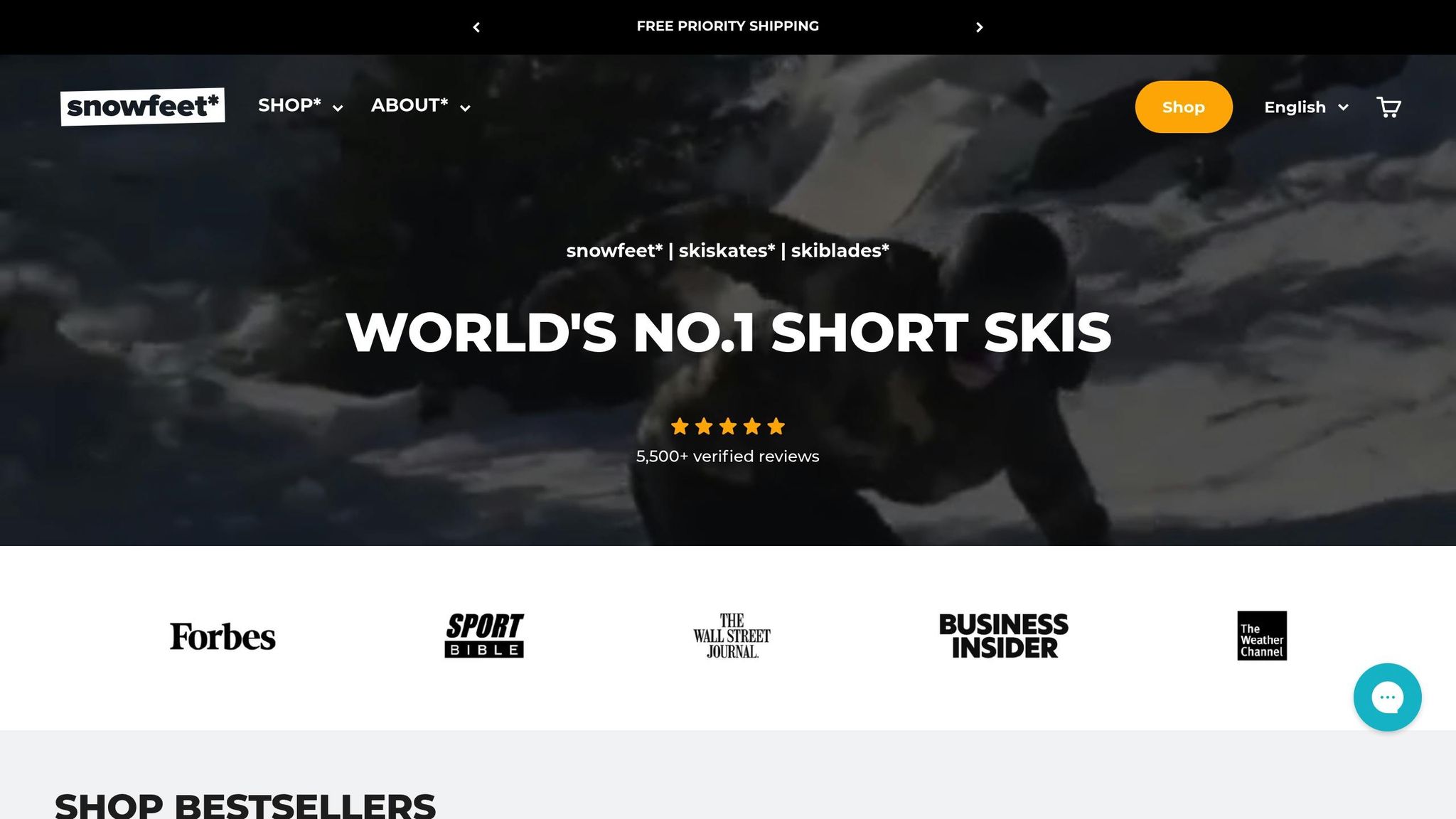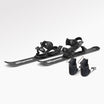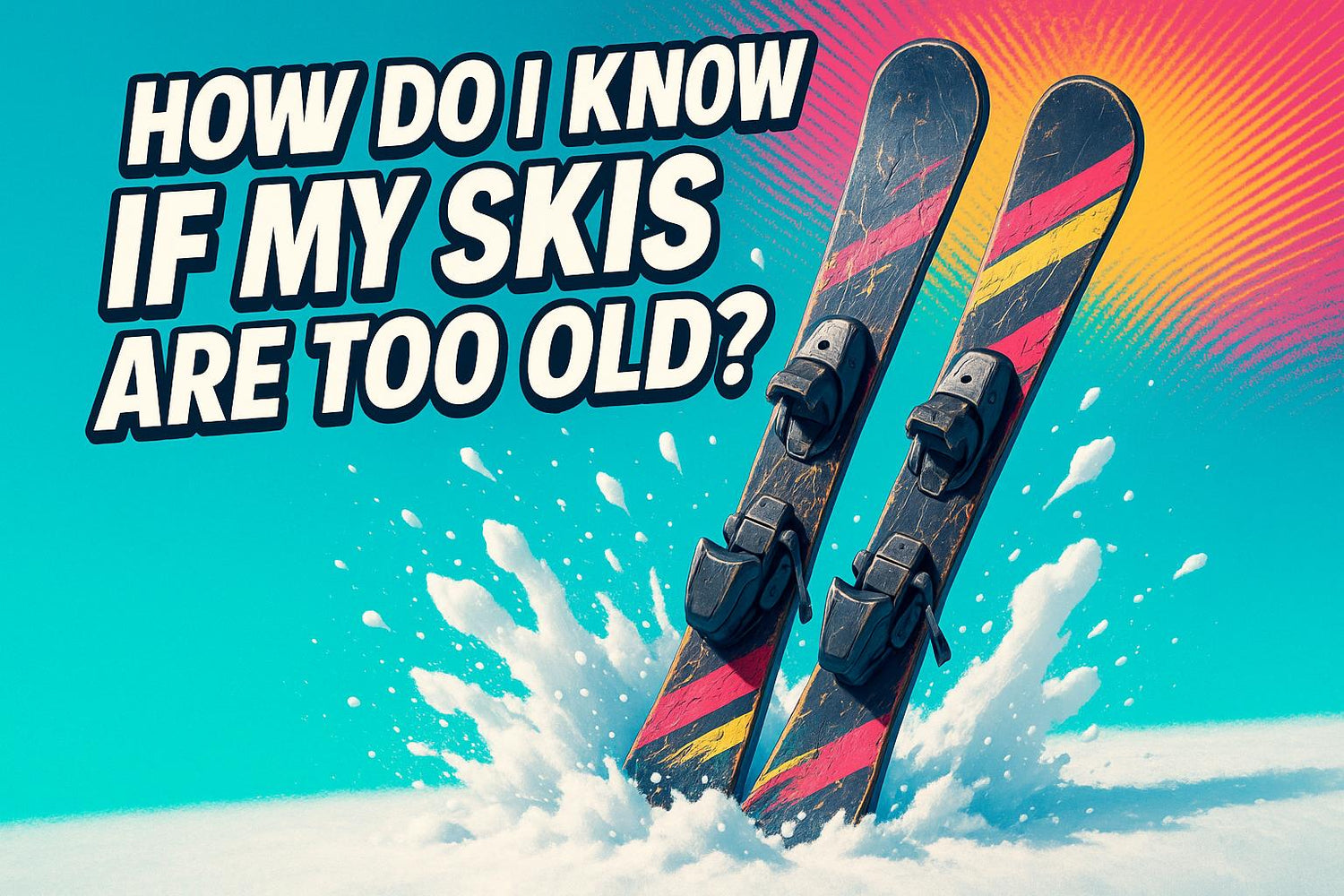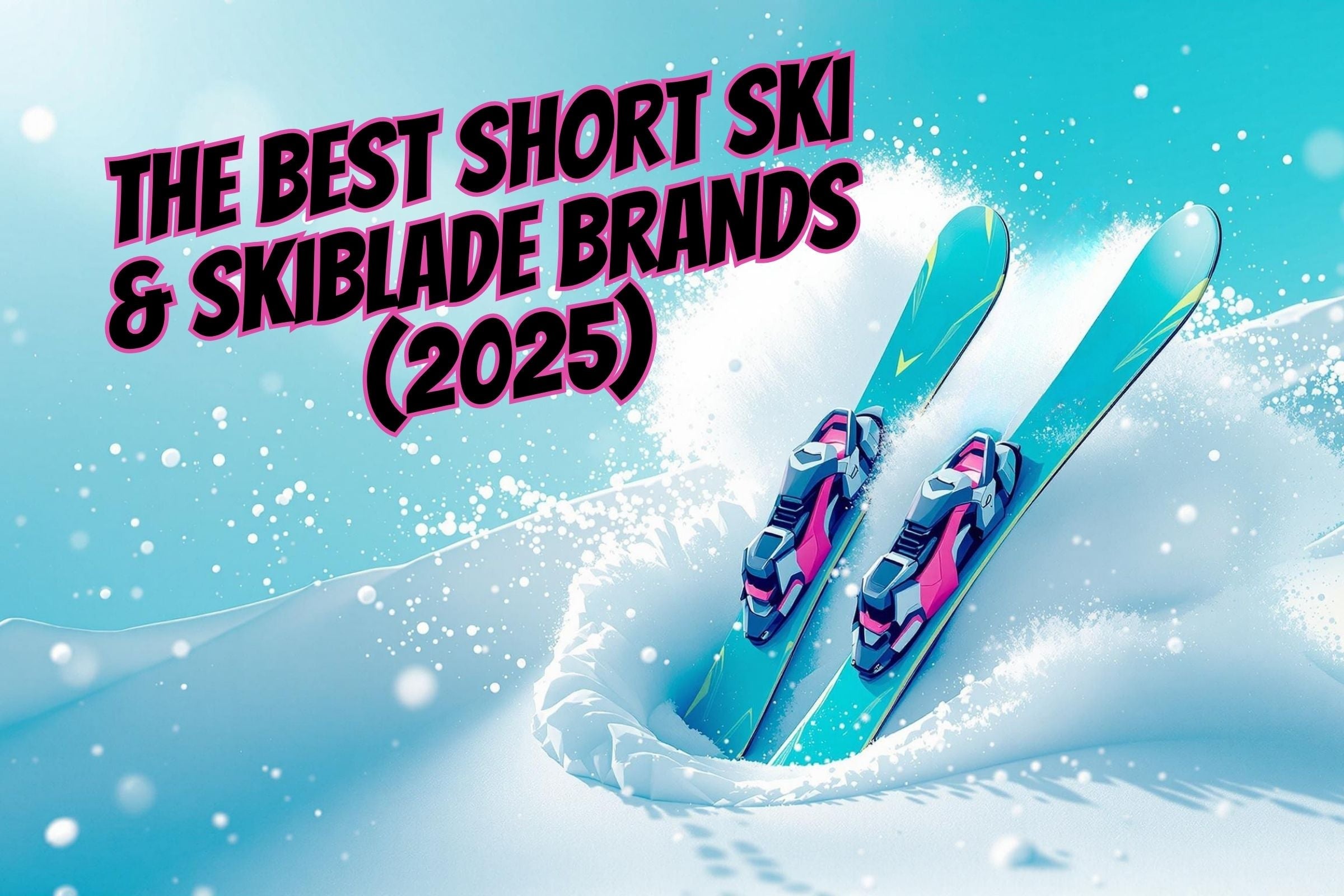Segnali Chiave che i Tuoi Sci Necessitano di Sostituzione:
- Danni Fisici: Graffi profondi, colpi al nucleo, bordi crepati o staccati, o delaminazione (strati che si separano).
- Problemi di Prestazione: Perdita di camber (arco sotto il piede) o rigidità torsionale (resistenza alla torsione), che porta a scarsa aderenza e controllo.
- Vecchi Attacchi: Attacchi con più di 10 anni o che mostrano ruggine, crepe o parti allentate potrebbero non essere più sicuri.
Durata degli Sci:
- La maggior parte degli sci dura 100–150 giorni sulle piste, circa 5–8 anni per gli sciatori occasionali. Gli sci da gara possono durare solo 50 giorni.
Snowfeet* Mini Skis: Un'alternativa moderna agli sci tradizionali:
- Compatti, resistenti e versatili per piste, sentieri e cortili.
- Più facili da mantenere e trasportare, con prezzi a partire da $150.
Confronto Rapido:
| Caratteristica | Snowfeet* (Mini Skis) | Sci tradizionali |
|---|---|---|
| Lunghezza | 15–47 pollici | 63–75 pollici |
| Peso | Leggero | Pesante |
| Calzature | Funziona con scarponi invernali | Richiede scarponi da sci |
| Costo | $150–$690 | $400–$1.200+ |
| Manutenzione | Minimo | Necessita di manutenzione regolare |
Quando Aggiornare?
- Cerca offerte durante febbraio–marzo o in bassa stagione (fine estate) per i migliori affari.
In sintesi: Se i tuoi sci mostrano danni, calo di prestazioni o attacchi obsoleti, è ora di sostituirli. Considera opzioni moderne come Snowfeet* per una soluzione più leggera e portatile.
Ispeziona i tuoi sci o tavola
Segnali che i tuoi Sci Sono Troppo Vecchi
Capire quando ritirare i tuoi sci non è sempre semplice. A differenza di uno scarpone rotto o di una giacca strappata, l'usura degli sci si manifesta gradualmente. Che tu stia sfrecciando con classici sci all-mountain Rossignol o girando con compatti Snowfeet* mini ski skates, ci sono alcuni segnali chiari che potrebbe essere il momento di un aggiornamento.
Danni Fisici
I segnali più facili da individuare sono i danni fisici. Inizia dalla base - controlla graffi profondi, solchi o core shots (quelle brutte incisioni che espongono il nucleo interno dello sci). I core shots sono seri e richiedono riparazioni professionali rapide per evitare che l'acqua penetri e rovini i tuoi sci.
Il prossimo punto: i bordi. I bordi smussati di solito si possono sistemare con una messa a punto, ma se hai bordi crepati o staccati, è finita. Quando il tuo tecnico degli sci dice che i bordi sono troppo compromessi per essere riparati, è ora di cambiare.
Il problema più grave? Delaminazione. È quando gli strati dei tuoi sci iniziano a staccarsi, di solito intorno ai bordi, alle punte o alle code. A differenza delle piccole scheggiature del topsheet (che sono solo estetiche), la delaminazione indebolisce la struttura dello sci e spesso segnala la fine della sua vita.
I prodotti Snowfeet*, con la loro costruzione compatta e i bordi metallici resistenti, rendono le ispezioni più facili. Inoltre, sono progettati per durare più a lungo rispetto a molti sci tradizionali.
Problemi di Prestazioni
A volte, i tuoi sci sembrano a posto ma semplicemente non si sentono giusti. Col tempo, possono perdere il loro camber (il leggero arco sotto il piede) e la rigidità torsionale (la loro capacità di torcersi e aggrapparsi). Questi problemi smorzano il rimbalzo, la reattività e la tenuta del bordo dei tuoi sci, specialmente sulla neve dura.
"Dopo un certo periodo gli sci possono perdere un po' di camber e vitalità. Non hanno più lo stesso rimbalzo e tenacia che avevano da nuovi." – Tricia, Admin & Tester SkiTalk
Il declino è così graduale che potresti non accorgertene - finché non provi un nuovo paio.
"Gli sci sono come ammortizzatori. Potresti non renderti conto di quanto sono usurati finché non ne prendi di nuovi. Il cambiamento è così lento che non lo noti giorno per giorno, ma se potessi sentire la differenza tra il primo e l'ultimo uso, la noteresti!" – Andy Mink, Moderatore & Tester SkiTalk
Per riferimento, gli sci da gara durano tipicamente circa 50 giorni di uso intenso, mentre gli sci all-mountain possono arrivare fino a 80 giorni. I prodotti Snowfeet*, con il loro design versatile, ti permettono di esplorare più di semplici piste battute, offrendoti un valore maggiore.
Vecchi Attacchi
Anche se i tuoi sci reggono, attacchi obsoleti possono essere un problema serio. Attacchi con più di 10 anni di solito non possono più essere revisionati per motivi di sicurezza. Le plastiche si degradano nel tempo, specialmente nelle punte completamente in plastica, rendendoli inaffidabili.
"Gli attacchi sono migliorati negli ultimi 25 anni, e i vecchi attacchi potrebbero non funzionare più in sicurezza." – Sibylle Hechtel, istruttrice di sci
Fai attenzione agli attacchi non indennizzati - questi non sono coperti dall'assicurazione di responsabilità del produttore, quindi la maggior parte dei negozi non li accetta. Inoltre, controlla la presenza di ruggine, plastica crepata, viti allentate o attacchi che non si sganciano correttamente durante una caduta.
I prodotti Snowfeet* sono dotati di attacchi moderni che rispettano gli standard di sicurezza attuali. Il loro design compatto esercita meno stress sugli attacchi rispetto alle forze generate dagli sci tradizionali più lunghi.
Questi segni non indicano solo quando i tuoi sci sono oltre il loro massimo - evidenziano anche i vantaggi di passare a opzioni moderne come Snowfeet*.
Segni di Usura per Snowfeet* e Short Skis

Snowfeet*, con il loro design compatto, richiedono un po' più di attenzione per quanto riguarda l'usura. A differenza degli sci tradizionali, la loro lunghezza più corta li rende più sensibili ai danni, e la loro capacità di affrontare terreni vari può portare a tipi specifici di usura.
Effetti della Piccola Superficie
Con Snowfeet* e altri short skis, ogni centimetro dello sci conta. Gli sci tradizionali, come quelli di marchi come Atomic o Head, possono variare da 65 a 70 pollici di lunghezza. Al contrario, Snowfeet* sono lunghi solo circa 15–20 pollici, il che significa che anche un piccolo graffio o danno al bordo può avere un grande impatto sul controllo e sulla presa - specialmente su neve ghiacciata o compatta.
Per esempio, una sgrottatura di 2 pollici potrebbe essere un problema minore su uno sci da 65 pollici, ma su uno Snowfeet* da 15 pollici occupa una porzione significativa della base, potenzialmente influenzando la scorrevolezza e la stabilità. Anche gli attacchi giocano un ruolo qui. Poiché coprono una proporzione maggiore della superficie dello sci, lo stress si concentra intorno ai punti di montaggio. Questo rende cruciale ispezionare crepe da stress o danni in quell'area, poiché potrebbe segnalare problemi strutturali precoci.
Questi sci più piccoli sono costruiti per la versatilità, ma la stessa compattezza significa che i loro segni di usura possono comparire più rapidamente, specialmente affrontando terreni diversi.
Portabilità e utilizzo
Uno dei vantaggi degli Snowfeet* è quanto siano portatili e versatili. Puoi usarli praticamente ovunque - sui sentieri escursionistici, nel tuo giardino o sulle piste battute. Ma questa flessibilità può anche portare a modelli di usura unici. A differenza degli sci tradizionali che restano per lo più su piste curate, gli Snowfeet* affrontano spesso condizioni più dure, come rocce, rami o altri detriti, che possono causare graffi o addirittura danni al nucleo.
Il trasporto di questi sci è un altro fattore. La loro portabilità significa che spesso vengono messi negli zaini o trasportati a mano, il che può causare scheggiature sul topsheet o ammaccature sui bordi. Inoltre, diversi tipi di calzature invernali possono creare pressioni irregolari sugli attacchi, quindi vale la pena controllare l'usura irregolare in quei punti.
Montaggi e smontaggi frequenti possono anche causare usura. Controlla i meccanismi degli attacchi e le cinghie per assicurarti che non si sfilaccino o si allentino.
Manutenzione facilitata
La buona notizia? Gli Snowfeet* sono progettati per affrontare queste sfide, e mantenerli non ti costerà una fortuna. Con prezzi a partire da circa 150$ per i Mini Ski Skates, sono molto più accessibili rispetto agli sci tradizionali di fascia alta, che possono costare dai 400 agli 800$ o più. Questo rende riparazioni o sostituzioni più facili per il tuo portafoglio.
Per mantenere i tuoi Snowfeet* in perfette condizioni, sono indispensabili controlli regolari. Dopo qualche utilizzo, dai un'occhiata attenta ai bordi, alla base e agli attacchi. Le loro dimensioni ridotte facilitano l'individuazione precoce di problemi, e intervenire rapidamente ti aiuterà a restare affilato sulla neve. Mantenendo la manutenzione aggiornata, non solo ne prolungherai la durata, ma sarai anche pronto a passare al modello più recente quando sarà il momento.
Perché scegliere gli Snowfeet* invece degli sci tradizionali
Se i tuoi sci hanno visto giorni migliori, potrebbe essere il momento di ripensare alla tua attrezzatura invernale. Invece di restare con sci tradizionali ingombranti, perché non provare qualcosa di più leggero, versatile e semplicemente più facile da usare? È qui che entrano in gioco gli Snowfeet*. Non sono solo un aggiornamento - sono un modo completamente nuovo di godersi la neve.
Per decenni, i grandi marchi hanno dominato il mercato degli sci con sci lunghi e pesanti che richiedono scarponi speciali, skipass e molto spazio per lo stoccaggio. Ma ammettiamolo - gli sport invernali stanno cambiando. Gli sci corti sono tornati sotto i riflettori, e per una buona ragione. Sempre più sciatori esperti si rendono conto che gli sci più corti possono offrire un'esperienza più fluida e divertente sulle piste. Non si tratta solo di cambiare l'attrezzatura; si tratta di cambiare il modo in cui si gode l'inverno.
Snowfeet* vs. Sci tradizionali: un confronto fianco a fianco
Ecco come Snowfeet* si confrontano con gli sci tradizionali di marchi come Rossignol, Atomic e Head:
| Caratteristica | Snowfeet* | Sci tradizionali |
|---|---|---|
| Lunghezza | 15–47 pollici | 63–75 pollici |
| Peso | Leggero; entra in uno zaino | Pesante; necessita di portapacchi o borse da sci |
| Calzature | Funziona con qualsiasi scarpa invernale | Richiede scarponi da sci costosi |
| Curva di apprendimento | Adatto ai principianti | Curva di apprendimento più ripida; intimidatorio per i principianti |
| Versatilità del terreno | Gestisce pendii, sentieri escursionistici, cortili e colline per slittino | Principalmente limitati a piste battute |
| Deposito | Si adattano a un armadio o a uno zaino | Necessita di spazio in garage o deposito specializzato |
| Trasporto | Facili da trasportare ovunque | Richiede portapacchi, borse da sci o noleggi |
| Costo | $150–$690 | $400–$1.200+ (più scarponi, attacchi e manutenzione) |
| Manutenzione | Manutenzione minima; super resistenti | Richiede regolare manutenzione, affilatura e riparazioni |
| Controllo della velocità | Facili da fermare e guidare | Più difficili da gestire a basse velocità |
Cosa rende Snowfeet* unici?
Snowfeet* sono costruiti con materiali all'avanguardia e un'ingegneria intelligente che non trovi negli sci tradizionali. La loro struttura rinforzata in fibra di vetro e i bordi metallici li rendono incredibilmente resistenti, così non devi preoccuparti di continue riparazioni o manutenzione. Dimentica delaminazioni o danni al nucleo - queste cose sono fatte per durare.
Un altro cambiamento rivoluzionario? Attacchi regolabili che funzionano praticamente con qualsiasi scarponcino invernale. Questo significa niente più scarponi da sci costosi e ingombranti. Non solo risparmi denaro, ma mantieni anche i piedi comodi tutto il giorno.
Ciò che davvero distingue Snowfeet*, però, è la loro versatilità. A differenza degli sci tradizionali che ti legano alle piste da sci, Snowfeet* ti permettono di esplorare molto di più. Pensa a sentieri stretti per escursioni, colline per slittini o anche il tuo giardino innevato. E poiché sono così portatili, puoi metterli nello zaino e partire per un'avventura sulla neve spontanea - niente portapacchi, niente complicazioni.
Per sciatori più anziani o chi cerca una giornata più rilassata sulle piste, Snowfeet* sono un sogno. Sono stabili, facili da controllare e perfetti per scivolare a velocità più basse. Inoltre, il loro design semplice e intuitivo li rende ideali per principianti e famiglie. Che tu sia nuovo agli sport invernali o voglia solo goderti la neve senza complicazioni, Snowfeet* rendono facile immergersi subito.
sbb-itb-17ade95
Consigli per la sostituzione degli sci
Mantenere la tua attrezzatura da sci in ottime condizioni è la chiave per divertirti sulle piste. Che tu usi sci tradizionali o i compatti prodotti Snowfeet*, ispezioni regolari possono evitarti problemi imprevisti e aiutarti a decidere quando è il momento di un aggiornamento. Ecco una guida per aiutarti a restare un passo avanti.
Lista di controllo per l'ispezione
Prima di ogni stagione sciistica, dedica qualche minuto a controllare la tua attrezzatura. Un piccolo sforzo ora può prevenire grandi problemi dopo.
Controlla i tuoi bordi
Passa le dita lungo i bordi metallici degli sci. Senti se ci sono zone ruvide o sbavature: possono segnalare danni. Per testare l'affilatura, gratta delicatamente il bordo con l'unghia; se toglie un po' di unghia, sei a posto. Bordi opachi o scheggiati indicano che è ora di un servizio professionale o addirittura di una sostituzione.
"I bordi che non hanno abbastanza mm per essere affilati o che si staccano mostrano segni che la vita dello sci è finita. Questo sci non può più essere affilato." - Renoun.com
Controlla anche la giunzione dove il bordo incontra la parete laterale. Se noti fessure o separazioni, potrebbe indicare problemi strutturali difficili da riparare.
Ispeziona la base
Capovolgi gli sci ed esamina la base. Una base ben mantenuta dovrebbe essere liscia e lucida. Se vedi macchie grigie o una superficie gessosa, è un segno che gli sci hanno bisogno di sciolinatura. Graffi minori possono spesso essere riparati, ma solchi profondi che espongono il nucleo indicano che è ora di nuovi sci.
Testa flessione e struttura
Fai un test di flessione sugli sci. Devono piegarsi in modo uniforme senza rigidità, punti molli o scricchiolii. Fai attenzione alla delaminazione: succede quando gli strati dello sci iniziano a staccarsi o a formare bolle.
Controlla i tuoi attacchi
Gli attacchi sono fondamentali per la sicurezza e le prestazioni. Assicurati che tutta la ferramenta sia sicura e che gli attacchi si muovano senza intoppi. Una manutenzione regolare, come la sciolinatura ogni 10–15 giorni e l'asciugatura accurata dopo ogni uso, li manterrà in buone condizioni.
Il momento migliore per aggiornare
Il tempismo è tutto quando si tratta di aggiornare la tua attrezzatura. Sapere quando fare acquisti può aiutarti a trovare ottime offerte e le migliori opzioni.
Saldi di fine stagione (febbraio–marzo)
I rivenditori spesso svuotano l'inventario a febbraio e marzo, offrendo sconti dal 20% al 60% sull'attrezzatura della stagione precedente. Sebbene le taglie e i colori più popolari possano esaurirsi rapidamente, questo è un ottimo momento per acquistare attrezzatura di alta qualità a un prezzo inferiore.
Offerte Fuori Stagione (Fine Estate/Inizio Autunno)
La fine dell'estate e l'inizio dell'autunno portano saldi per il Labor Day e altre promozioni, dandoti tempo per ricercare e confrontare le opzioni senza la pressione di un imminente viaggio sugli sci. È un periodo di acquisti più tranquillo, quindi puoi prenderti il tuo tempo.
Saldi di Black Friday e Festivi
Il Black Friday è un'altra occasione per risparmiare, anche se la selezione potrebbe essere limitata ai modelli che i rivenditori vogliono smaltire. Se stai pensando di passare ai prodotti Snowfeet*, questa potrebbe essere l'opportunità perfetta.
Acquisti a Inizio Stagione
Se cerchi l'attrezzatura più recente e non ti dispiace pagare il prezzo pieno, fai acquisti all'inizio della stagione sciistica. Avrai accesso alla tecnologia più nuova e a una gamma completa di misure. Per gli appassionati di Snowfeet*, questo è il momento migliore per esplorare tutta la loro linea, dai Mini Ski Skates compatti da 15 pollici ($150) agli Short Skis da 47 pollici ($690).
Considera l'Attrezzatura Demo
Molti negozi di sci vendono attrezzatura demo a prezzo scontato prima della fine della stagione. Questi sci sono stati usati leggermente in condizioni controllate e possono essere un modo economico per aggiornare senza sacrificare la qualità.
Conclusione: Aggiorna per un'Avventura Invernale Più Sicura e Fluida
Sciare con sci usurati può influire seriamente sulle tue prestazioni e, cosa più importante, sulla tua sicurezza. Se i tuoi sci mostrano segni come usura pesante della base, bordi danneggiati o delaminazione, è il momento di considerare un aggiornamento. L'attrezzatura vecchia e stanca non solo offre prestazioni scadenti, ma riduce anche il controllo e aumenta il rischio di incidenti. Al contrario, aggiornare la tua attrezzatura migliora il controllo, aumenta la fiducia e porta la tua esperienza sciistica al livello successivo.
È qui che entrano in gioco opzioni moderne come Snowfeet*. I loro prodotti, come i Mini Ski Skates a partire da $150 e gli Skiskates da $390, offrono un'alternativa leggera e compatta agli sci tradizionali. Questo design non solo li rende più facili da trasportare, ma riduce anche l'usura di attacchi e bordi. Meno manutenzione, meno preoccupazioni per i danni e prestazioni più durature fanno parte del pacchetto. Inoltre, il loro design portatile significa meno problemi di sicurezza rispetto agli sci tradizionali più ingombranti.
Come accennato in precedenza, problemi come i bordi danneggiati e la delaminazione possono rappresentare rischi seri. Che tu scelga di restare con gli sci tradizionali o opti per i design innovativi di Snowfeet*, aggiornare la tua attrezzatura ti assicura di rispettare gli standard di sicurezza odierni e di ottenere prestazioni affidabili. Non lasciare che l'attrezzatura obsoleta ti trattenga - fai il cambio e goditi ogni discesa con fiducia. Con Snowfeet*, sei pronto a elevare le tue avventure invernali in ogni modo.
Domande Frequenti
Come posso capire se i miei attacchi da sci sono troppo vecchi e non sicuri da usare?
Per capire se i tuoi attacchi da sci sono troppo vecchi o non sicuri, inizia controllando la loro età. Se hanno 10–15 anni o più, probabilmente sono obsoleti e potrebbero non rispettare gli standard di sicurezza attuali. Controlla attentamente eventuali segni di danni - come ruggine, crepe o viti allentate - perché possono influire seriamente sulle prestazioni e sulla sicurezza. Un altro segnale d'allarme? Se il produttore non supporta più o non garantisce i tuoi attacchi, è sicuramente ora di sostituirli.
La maggior parte dei negozi di sci non effettua nemmeno la manutenzione degli attacchi più vecchi di 10 anni perché il rischio di guasti è troppo alto. Passare a un'attrezzatura più nuova non solo aumenta la sicurezza, ma può anche portare il tuo sci a un livello superiore grazie a design e tecnologie moderne.
Cosa rende Snowfeet una scelta migliore rispetto agli sci tradizionali?
Snowfeet: Un Tocco Divertente allo Sci Tradizionale
Snowfeet porta una ventata di freschezza sulle piste. La loro attrezzatura, come Skiblades e Skiskates, è più piccola, leggera e facile da maneggiare, rendendola una scelta fantastica per principianti o chi vuole un'esperienza più rilassata e giocosa. A differenza degli sci più ingombranti e tradizionali di marchi come Rossignol o Atomic, i prodotti Snowfeet puntano a curve rapide e fluide e a una manovrabilità senza sforzo.
Una caratteristica che spicca? Il loro design compatto e portatile. Non servono borse da sci oversize o portapacchi sul tetto - basta metterli in uno zaino e sei pronto a partire. Questo li rende perfetti per sciatori occasionali o chiunque cerchi un'attività invernale semplice e senza stress. Se cerchi attrezzatura leggera, facile da gestire e che ti aiuti a prendere confidenza sulle piste, Snowfeet potrebbe diventare il tuo nuovo preferito.
Qual è il momento migliore per comprare nuova attrezzatura da sci e risparmiare?
Il momento migliore per trovare offerte incredibili sull'attrezzatura da sci? Da fine febbraio a inizio aprile, con marzo come periodo ideale. I rivenditori abbassano i prezzi sull'equipaggiamento della stagione passata per fare spazio alle novità. È l'occasione perfetta per aggiornare la tua attrezzatura senza spendere troppo.
Stai pensando di provare qualcosa di nuovo? Considera i prodotti Snowfeet come Skiblades, Skiskates o altri sci corti. Questi design compatti e moderni offrono un'alternativa divertente e facile da usare rispetto ai marchi tradizionali come Rossignol o Atomic. Se vuoi dare una svolta alle tue discese, questo potrebbe essere il momento giusto per cambiare.

































Lascia un commento
Questo sito è protetto da hCaptcha e applica le Norme sulla privacy e i Termini di servizio di hCaptcha.